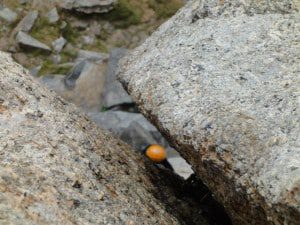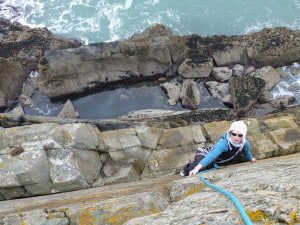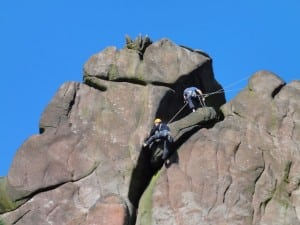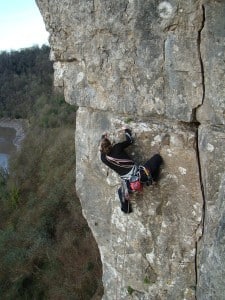Turning up at a crag you’ve never been to before and expect to find something suitable  to climb would be very difficult indeed. If you are new to an area and/or new to climbing you need to find out where the climbing venues are and their suitability for you as a climber. The local climbing shop or climbing centre is a good place to start (or the internet, of course), where you are likely to meet local climbers who know the area well and can point you in the right direction. A guide book is a must. It will tell you:
to climb would be very difficult indeed. If you are new to an area and/or new to climbing you need to find out where the climbing venues are and their suitability for you as a climber. The local climbing shop or climbing centre is a good place to start (or the internet, of course), where you are likely to meet local climbers who know the area well and can point you in the right direction. A guide book is a must. It will tell you:
- Where the crags are located and how to get to them.
- The historical background – who developed the area, ethics etc.
- Any access issues or restrictions.
- The lay out of the crags, including which direction they face, approaches and how to get off.
- The type of rock and style of climbing.
- Whether the crags are single or multi-pitch.
- Whether there are in-situ belays.
- The name, grade, description and first ascentionist for each climb.
- Graded lists.
As well as many diagrams and photographs to give the essence of the climbing and to ensure you are in the right place.

Where have all the coloured blobs gone? There aren’t any. One of the biggest problems facing the new outdoor climber is being able to read the rock. So far they have been able to move from one coloured hold to the next, the obvious line of the climb always visible, but outdoors it’s more subtle. The holds are more difficult to identify and may appear to be poor on first contact, but with just a small shift of body position or feet the holds become more useful.
Although you are on a top/bottom rope so you are following the line of the rope, it

doesn’t necessarily mean that is where the route goes. You have to look at the big picture; there may be a better hand or foot hold out to the left or right, you may have to shift your body weight to reach it. On the more popular routes there may be tell tale signs of wear on the rock, or dark marks where countless climbing shoes have embraced the rock.
There are many different types of rock that create dramatic scenery and entice the climber to want to explore them. The sculpted rock of Gritstone found in the Peak District and Yorkshire, often offer quite short routes but packed with adventure and brutal climbing.

Metamorphic rock occurs in Pembrokeshire in the are of St.Davids, forming a dramtaic coastline of slabs of varying angles. Fair Head in Northern Ireland is Dolerite and considering the extent and quality of the rock it is surprising it doesn’t attract more climbers. This may be due to its remoteness and the physical strength and unfamiliar climbing techniques that are required. Although above the sea it is not considered to be a sea cliff but a mountain crag and sits on a layer of chalk. It is well worth a visit, although it is quite physical and takes a while to get used to.
The complex Quartzite rock of Gogarth on Anglesey create magnificent, atmospheric sea cliffs. Hard Granite cliffs are found as far apart as Cornwall, North Wales and the Lake District producing single and multi-pitch crags that offer sport for all types of climber.

Limestone is widespread throughout the United Kingdom: where it is quarried it is often bolted for sport climbing, but where it occurs naturally it is left to be climbed in the traditional way using leader protection.
Limestone offers some of the most beautiful and varied climbing in the United Kingdom. Other rock types you might come across in your pursuit of vertical pleasure are Sandstone, Slate, Rhyolite, Gneiss and Schist.
To develop your skills and experience and become a rounded climber it is essential to climb on all rock types.